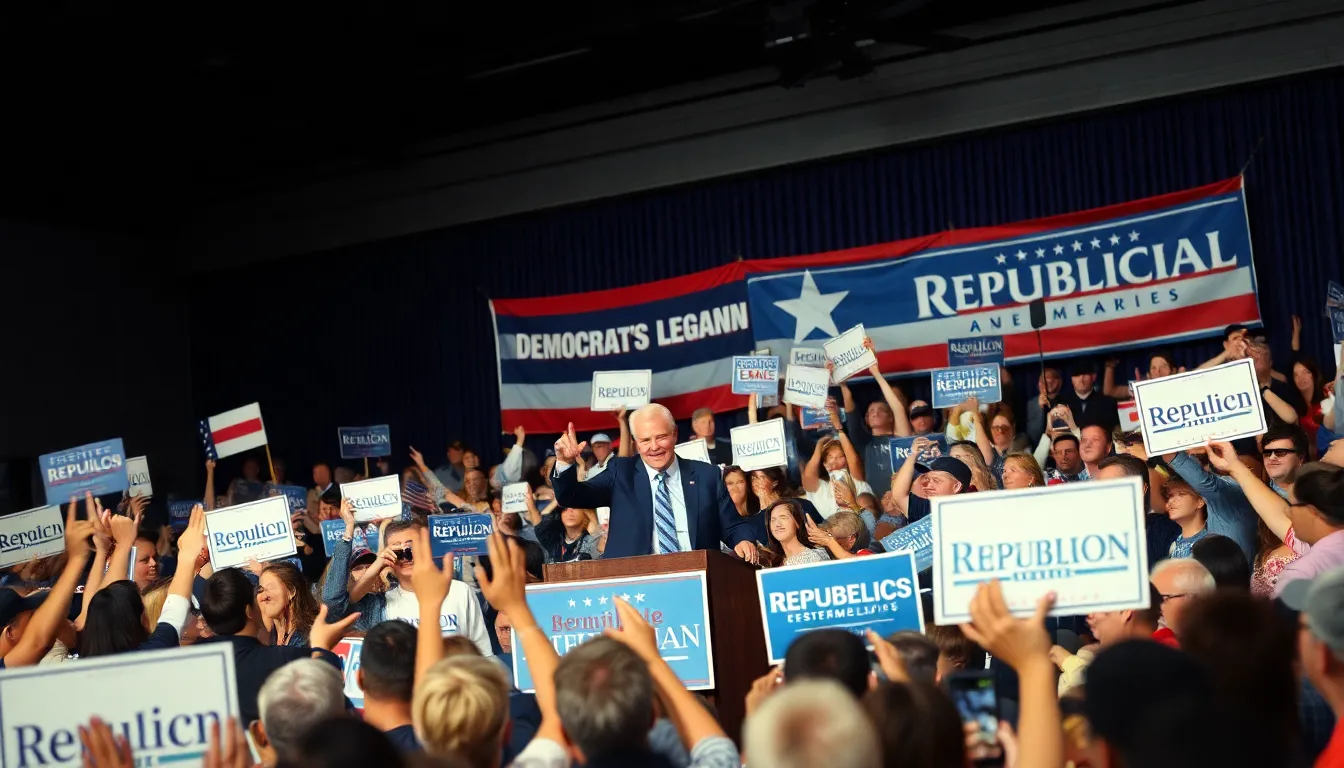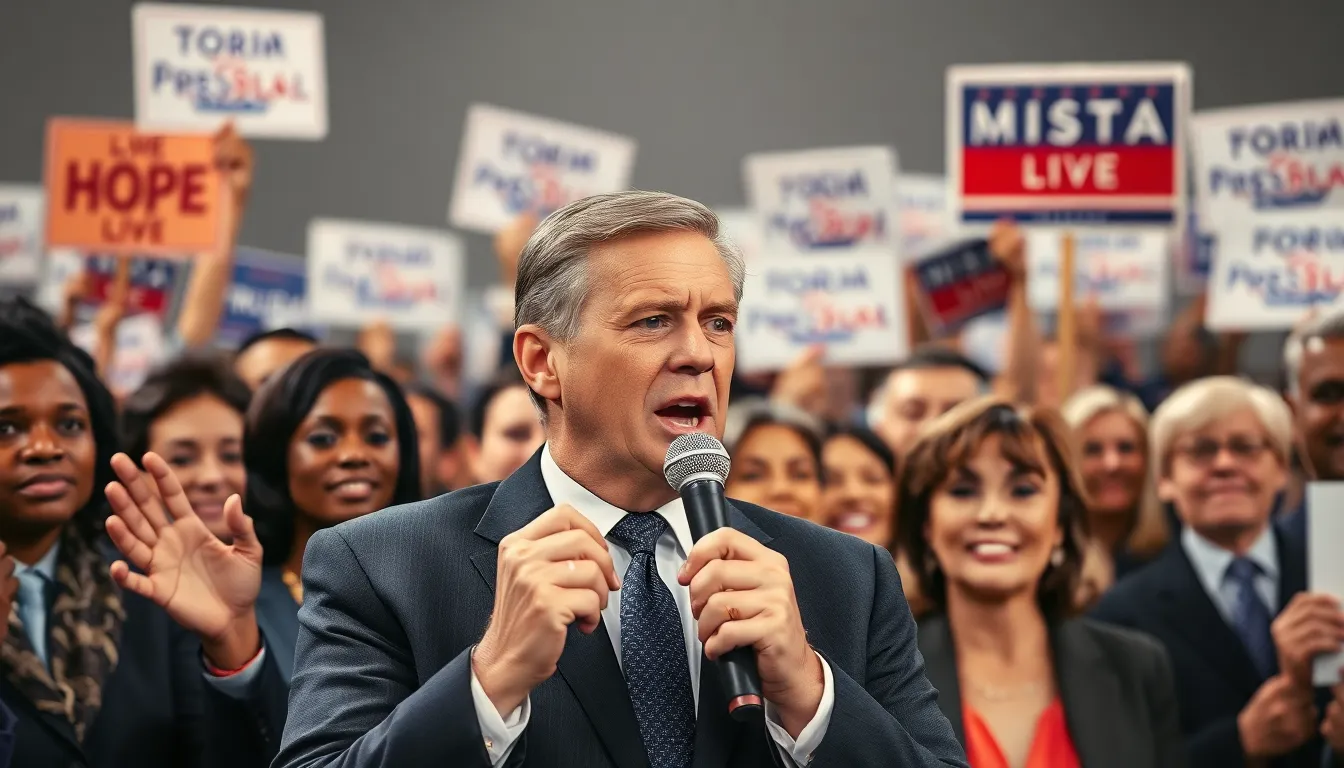As the race for the presidency heats up, the political stage is buzzing with a colorful cast of characters, each vying for the nation’s top job. From seasoned politicians to fresh-faced challengers, the lineup reads like a reality show—complete with drama, unexpected twists, and a few plot holes that would make even the best writers cringe.
Table of Contents
ToggleOverview of Presidential Candidates
Multiple candidates are entering the race for president, representing various political ideologies and backgrounds. The Republican Party features several notable figures, including former President Donald Trump, whose influence remains significant. Florida Governor Ron DeSantis stands out as another prominent contender, leveraging his executive experience to appeal to primary voters.
On the Democratic side, President Joe Biden seeks re-election, maintaining a strong focus on economic recovery and social issues. Meanwhile, California Governor Gavin Newsom has emerged as a potential candidate, emphasizing progressive policies that resonate with younger voters.
Independent candidates also make their presence known. Noteworthy among them is Marianne Williamson, who advocates for a holistic approach to governance. Her platform targets mental health and social justice, appealing to voters interested in alternative views.
Newcomers are also making waves. For example, entrepreneurs like Vivek Ramaswamy are introducing fresh perspectives, drawing attention with their outsider status and innovative ideas. Each candidate brings unique strengths to the table, from established political networks to grassroots campaigning.
Polling data illustrates the fluctuating dynamics of the race, with candidates gaining or losing support based on their policy positions and public appearances. The landscape continues to evolve, with debates and events further shaping voter opinions. The current landscape reflects a vibrant democracy, full of varied choices for potential voters.
Major Party Candidates

The current presidential race features a variety of candidates from major political parties. Each candidate brings unique perspectives and strategies to the election.
Democratic Party Contenders
President Joe Biden seeks re-election, prioritizing economic recovery and social issues. California Governor Gavin Newsom presents himself as a strong contender, focusing on progressive policies that resonate with younger voters. Marianne Williamson continues to campaign as an independent, emphasizing mental health and social justice. These candidates reflect a commitment to addressing significant challenges facing the United States.
Republican Party Contenders
Former President Donald Trump maintains a significant presence, appealing to his base with issues central to conservative voters. Florida Governor Ron DeSantis stands out with executive experience, positioning himself as a viable alternative. Other candidates also enter the race, each vying for recognition and support. The Republican landscape remains competitive, reflecting diverse viewpoints within the party.
Independent and Third-Party Candidates
Independent and third-party candidates play a crucial role in the presidential race, offering alternative options to traditional party lines. Marianne Williamson seeks to attract voters with her focus on mental health and social justice, appealing to those disillusioned with mainstream politics. Additionally, Robert F. Kennedy Jr. runs as an independent, emphasizing public health and vaccine awareness, which resonates with certain voter groups.
Third-party candidates like Cornel West, representing the Green Party, advocate for environmental justice and equitable economic policies. West’s platform targets young voters eager for environmental reform and social equity. Another notable candidate is Jorgensen, who represents the Libertarian Party, stressing individual freedom and minimal government intervention. Her appeal lies in attracting libertarian-minded individuals valuing limited government against sprawling federal authority.
Polling data reveals that these independent and third-party candidates can impact the overall dynamics of the race. Voter sentiment shifts based on candidates’ stances on key issues, often influencing larger parties’ strategies. By visiting various forums and debates, these candidates highlight contrasting ideologies, allowing voters to choose based on personal values rather than party loyalty.
The presence of independent candidates fosters a more vibrant democracy, challenging the traditional binary political system. As the race progresses, their ability to connect with voters on crucial issues could determine the election outcome, making independent and third-party candidates essential to the current political landscape.
Key Issues Influencing the Race
Primary concerns influencing the presidential race include the economy. Many candidates, particularly Republicans, emphasize inflation and job creation as critical issues. Voters express significant interest in how each candidate plans to stimulate growth and manage public debt.
Health care remains another focal point. Candidates like Joe Biden advocate for expanding access to affordable care, while others argue for alternatives. The debate over public health policies, especially in the context of recent pandemic responses, resonates with voters.
Social justice also plays a prominent role. Progressive candidates, including Gavin Newsom, prioritize issues like racial equality and criminal justice reform. Engaging younger voters on these matters can sway election outcomes.
Climate change generates considerable discussion. Figures like Cornel West highlight the urgency of addressing environmental issues. Voters recognize the need for sustainability and demand clear plans from candidates.
Foreign policy causes differing perspectives among candidates. While some, like Donald Trump, focus on national security and immigration, others propose more diplomatic approaches. The varying stances on international relations can determine candidate appeal in this globalized era.
Education shapes public opinion as well. Candidates propose diverse solutions to address disparities in access and quality. Effective education policy discussions can resonate with families and younger voters alike.
Lastly, individual freedom and government intervention surface as contentious topics. Libertarian candidates prioritize minimal government intrusion, appealing to a section of the electorate. Each of these issues influences voter preferences and candidate strategies significantly throughout the campaign.
Candidate Profiles
The presidential race features candidates showcasing distinct backgrounds and experiences. Below are insights into notable achievements and controversies facing key players in the election.
Notable Achievements
Donald Trump, the former President, successfully implemented tax cuts and strengthened the economy during his term. Ron DeSantis, as Florida’s Governor, garnered attention for his management of the COVID-19 pandemic, gaining support among conservative voters. President Joe Biden’s achievement includes passing the American Rescue Plan, a significant COVID-19 response initiative. Gavin Newsom focuses on progressive reforms in education and environmental policies, aiming to attract younger voters. Vivek Ramaswamy, an entrepreneur, made headlines with innovative approaches to corporate governance. Marianne Williamson advocates for mental health awareness and social justice, appealing to those seeking holistic leadership.
Controversies and Challenges
Trump continues to face scrutiny over legal issues related to his presidency and business practices. DeSantis navigates criticism regarding his pandemic response and education policies that critics label as divisive. Biden confronts challenges on economic recovery, especially with inflation concerns impacting voter sentiment. Newsom’s handling of homelessness in California generates mixed reactions, complicating his support. Ramaswamy often receives backlash for his outsider perspective, which some deem untested. Williamson and other independent candidates face obstacles in gaining visibility and support against more established contenders, complicating their paths in the race.
The 2024 presidential race is shaping up to be one of the most dynamic in recent history. With a mix of seasoned politicians and fresh faces, candidates are addressing critical issues that resonate with voters. Each contender brings unique perspectives and strategies that could redefine party lines and voter engagement.
As the election approaches, the influence of independent and third-party candidates becomes increasingly significant. Their presence offers alternatives to traditional politics and can sway public opinion on key issues. The evolving landscape will undoubtedly keep voters engaged and informed as they prepare to make their voices heard in the upcoming election.




